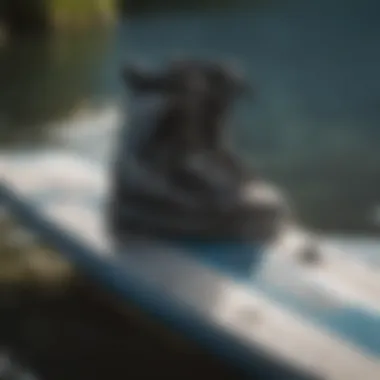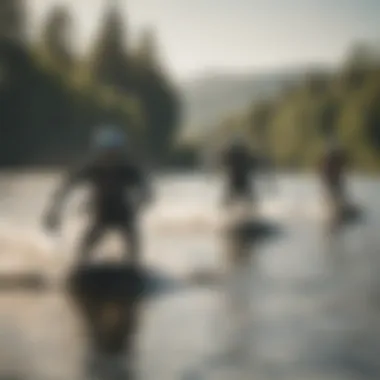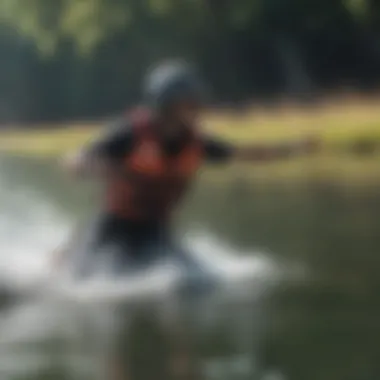Exploring the Wakeboard Scene: Techniques and Culture


Intro
Wakeboarding blends skill, adrenaline, and a vibrant community into a single activity that captives thrill-seekers and adventure lovers alike. Understanding the deeper aspects of wakeboarding—not just the enjoyment it brings—requires an exploration into its techniques, essential gear, safety measures, and the culture that surrounds it. This article aims to unfold these elements, guiding both newcomers and seasoned participants through the multifaceted world of wakeboarding.
Techniques and Tips
Skill Development
Developing skills in wakeboarding is a progressive journey. Beginners can start by mastering the basics, such as stance and balance. Practicing on dry land can build familiarity, minimizing the initial fear of falling into the water. Once confidence builds, advancing to different skills like jumping, spins, or flips becomes a natural progression. Consistent practice is key, along with constructive feedback from peers.
Practical Techniques
- Stance: Maintain a shoulder-width stance with knees slightly bent.
- Edge Control: Use your legs to shift your weight from heel to toe to control your direction.
- Jumping: Approach jumps with speed, and use the pop from the wake to launch yourself.
- Landing: Focus on bending your knees upon landing to absorb impact and maintain balance.
While these practices may seem simple, understanding their technicalities deepens proficiency in wakeboarding. Each ride on the water is a chance to refine these techniques.
Common Mistakes to Avoid
Absolutely, there are frequent missteps that beginners can learn to avoid:
- Gripping the handle too tightly, which restricts movement.
- Forgetting to keep knees bent while carving.
- Trying advanced tricks too early without sufficient practice.
Awareness of these mistakes can prevent injury and foster a more enjoyable learning experience.
Gear and Equipment
Essential Gear for Beginners
For those entering the wakeboarding realm, selecting the right gear is paramount. The essentials include:
- Wakeboard: Choose a board appropriate for your weight and skill level.
- Bindings: Comfort and fit are crucial; ensure they provide adequate support.
- Life Jacket: A safety vest designed for water sports enhances safety and is often required by law.
This gear will provide a solid foundation for engaging in this sport effectively.
Latest Innovations and Trends
The wakeboarding gear landscape continually evolves, integrating advancements such as lightweight materials and enhanced buoyancy. Notable innovations include:
- Paddleboards with integrated tech for tracking performance.
- Bluetooth-enabled speakers for a more entertaining experience on the water.
These trends reflect a growing interest in personalizing the wakeboarding experience, making it more enjoyable and connected.
Reviews and Comparisons
When evaluating products, methods of comparison can enhance decision-making:
- Performance: Look for reviews that assess responsiveness and stability.
- Durability: Consider the material quality and wear resistance.
- Price: Balance quality with budget without sacrificing essential functions.
Taking time to review these aspects can lead to more informed purchases.
Safety Measures
Essential Safety Gear
Safety is non-negotiable when participating in wakeboarding. Key items include:
- Helmets: Mandatory for protecting the head during falls.
- Impact Vests: Help minimize injuries from hard landings.
Equipping oneself with proper safety gear is fundamental in preventing accidents.
Best Practices for Safe Participation
Follow these guidelines to ensure a smooth experience:
- Ride in designated areas to avoid collisions.
- Always have a spotter on the boat to watch for hazards.
- Maintain proper distance from other riders and objects.
Implementing these practices can enhance safety.
Injury Prevention and Management
Familiarity with common injuries in wakeboarding allows participants to take precautions. Basic strategies involve:
- Warming up before riding.
- Employing correct techniques to reduce risk of strain.


In the event of injury, having a recovery plan is crucial for a quick return to the sport.
Spotlights on Extreme Sports
Featured Sport of the Month
Recognizing a highlighted sport monthly informs athletes about trends and events. Recent features include kiteboarding, which shares a close relationship with wakeboarding. It emphasizes similar skills like balance and maneuvering.
Profiles of Prominent Athletes
Celebrating key figures in wakeboarding can motivate both newcomers and veterans. Athletes like Parks Bonifay and Danny Harf have all made significant contributions to the sport, showcasing impressive techniques and achievements that inspire others.
"Wakeboarding isn't just a sport—it's a lifestyle built on passion, community, and adventure."
By exploring these diverse aspects of wakeboarding, participants can engage with it fully, forming deeper connections with both the sport and its community.
Prologue to Wakeboarding
Wakeboarding has emerged as a captivating sport, attracting enthusiasts from various backgrounds. This introduction serves to outline the significance of understanding wakeboarding, especially for those new to the scene. For both thrill-seekers and athletes, grasping the fundamentals can enhance the overall experience. It is crucial to appreciate the blend of skill, balance, and the rush of gliding on water.
Definition and Origin
Wakeboarding combines elements of water skiing, snowboarding, and surfing. The origins of wakeboarding date back to the late 1980s. Brought forth by pioneers such as Tony Finn and a few others, the sport evolved quickly. Using a surfboard strapped to the feet, riders initially relied on the power of boats for propulsion. Over time, this has led to the development of specialized boards and techniques.
The sport gained popularity as a unique form of water recreation. Its inclusive nature attracts people of all ages and abilities. Today, wakeboarding is recognized worldwide, with both casual participants and competitive athletes pushing the boundaries of what is possible on the water.
The Thrill of Wakeboarding
For many, the thrill of wakeboarding stems from the adrenaline rush it provides. The cacophony of wind and water creates an immersive experience, wherein riders feel fully alive. The sensation of being towed across the water and launching into the air is exhilarating.
Beyond sheer excitement, wakeboarding also offers a profound sense of freedom. Riders can experiment with various techniques and tricks, allowing for personal expression. Each session can be different, shaping a unique rapport between rider and environment. This constant evolution keeps practitioners engaged and motivated to improve their skills.
"Wakeboarding is not just a sport; it's a lifestyle that fosters community and growth."
In summary, the introduction to wakeboarding provides insights into its definition and a glimpse into its origins. Furthermore, it highlights the thrill that draws many individuals to the sport. This foundation will pave the way for a deeper exploration into the techniques, gear, and culture surrounding wakeboarding.
Understanding the Basics of Wakeboarding
Understanding the basics of wakeboarding is essential for anyone interested in the sport. This foundational knowledge sets the stage for developing skills and ensuring safety. Many newcomers may feel overwhelmed by the techniques and equipment involved. However, familiarizing oneself with the primary concepts can alleviate confusion.
Learning the critical techniques can lead to immediate improvements. For instance, mastering the correct stance boosts performance and enhances enjoyment on the water. Additionally, it is important to recognize how balance and posture play an integral role in riding successfully. This is not only about athleticism but also about ensuring a rewarding experience on the board.
Moreover, knowing the basic principles of wakeboarding enriches the connection to its vibrant culture. From understanding the development of the sport to appreciating its community, the basics foster an environment for growth and communication among enthusiasts.
Essential Techniques for Beginners
For beginners, grasping essential techniques can make the difference between frustration and fun. A few techniques deserve mention here:
- Starting Position: Begin in a seated position in the water, with the board in front at a 45-degree angle.
- Hold the Handle Correctly: Keep both hands on the handle. This grip provides stability when you are about to rise.
- Rising Up: As the boat accelerates, allow the boat to pull you up instead of trying to jump. Keep your knees bent, and let the board and water work together.
These techniques seem simple but require practice. Understanding the body movements and muscle engagements will lead to smoother rides.
Importance of Balance and Posture
Balance and posture are perhaps two of the most crucial aspects in wakeboarding. A well-managed position influences your speed and control on the water. Here are some key considerations:
- Core Stability: Engaging your core helps maintain balance. A strong core allows for quicker adjustments.
- Feet Placement: Positioned correctly, your feet should be centered on the board. This ensures that weight is evenly distributed, which is vital for control during maneuvers.
- Knees: Always keep your knees slightly bent. This simple adjustment absorbs shocks from the water and aids in maintaining better control.
Maintaining the right balance and posture can greatly enhance both performance and safety in wakeboarding.
In summary, understanding the basics of wakeboarding establishes a strong foundation. Dive into techniques that promote balance and posture, as these will serve as pillars in the journey of becoming a proficient wakeboarder.
Gear and Equipment for Wakeboarding
Understanding the right gear and equipment is crucial for every wakeboarder. Your choice of gear can significantly influence both performance and safety on the water. Each component, from the wakeboard itself to the safety gear, forms an integral part of the wakeboarding experience. Investing in quality equipment not only enhances skills but also ensures that riders can enjoy their sessions with confidence.
Types of Wakeboards Explained
The selection of a wakeboard largely depends on the rider's skill level, style, and the type of riding they prefer. There are various types of wakeboards available, including:
- All-around wakeboards: These are versatile options suitable for beginners and experienced riders alike. They work well on various terrains and waters.
- Cable park boards: Designed for use in a cable park, these boards typically feature a softer flex and are constructed to withstand obstacles like rails and boxes.
- Boat wakeboards: Engineered for being towed behind a boat, these boards have a stiffer construction that allows for better performance on wakes.
Each type of wakeboard caters to specific riding styles, so it is important to choose one that feels comfortable and enhances your abilities on the water.
The Role of Bindings and Boots


Bindings and boots serve as the connection between the rider and the wakeboard. Choosing the appropriate bindings is essential for both performance and safety. They come in different styles, including closed-toe and open-toe options.
- Closed-toe bindings offer more support and a snug fit, making them ideal for more advanced riders who perform tricks and stunts.
- Open-toe bindings are more adjustable, which makes them suitable for beginners as they are often more comfortable and flexible.
The right fit is necessary to avoid tension or discomfort while riding. Snug but not restrictive bindings allow for better control and balance.
Safety Gear: Importance and Options
Wakeboarding comes with certain risks, which is why safety gear is non-negotiable. The most common safety equipment includes:
- Life jackets: A properly fitted life jacket is essential. It should be comfortable yet snug to ensure it stays on during a fall. Look for options that are specifically designed for water sports.
- Helmets: A helmet can protect the rider's head during falls or collisions.
- Impact vests: These vests can help absorb the shock during impact, making them valuable for anyone performing tricks.
It’s vital to prioritize safety; gear should not only be comfortable but must satisfy safety regulations too.
By understanding and equipping oneself with the right gear and equipment, riders can embark on their wakeboarding journeys with enhanced confidence and the thrill of embracing the waves.
Advanced Wakeboarding Techniques
Advanced wakeboarding techniques separate the novices from the seasoned riders. These skills enhance control, creativity, and overall performance on the water. Mastering advanced techniques is crucial for those who wish to push their limits and explore the full breadth of what wakeboarding offers. This section focuses on the intricate aspects of tricks and stunts, providing insights into the methodology and finesse involved.
Tricks and Stunts
The world of wakeboarding is filled with various tricks and stunts that showcase skill and style. These advanced maneuvers not only elevate a rider's performance but also add excitement to the sport.
Spin Variations
Spin variations are integral to wakeboarding. This technique involves rotating on the board while in the air. A key characteristic is the degree of rotation, as riders can perform 180-degree spins up to 720-degree spins or more. Spin variations are popular because they provide riders with opportunities for creativity and expression. The unique feature of spins is their versatility; they can be combined during jumps or employed within a series of tricks.
- Advantages: Enhances showmanship, improves air awareness.
- Disadvantages: Requires precise timing and balance.
Skilled riders often incorporate spin variations in competition routines, showcasing their technical know-how.
Flips and Inverts
Flips and inverts represent another level of wakeboarding expertise. These moves entail rotating the board and the rider upside down in mid-air. The key aspect of flips is the height achieved before the maneuver, which adds to the overall spectacle.
They are beneficial for increasing a rider’s resume in competitions. Additionally, flips can impress spectators with their technical intricacy. One unique feature of flips and inverts is that they require a strong commitment and a thorough understanding of body mechanics.
- Advantages: Engages crowds, demonstrates control.
- Disadvantages: Higher risk of falls or injuries if not done correctly.
Riders often prefer flips for their visually engaging nature, as they enhance performance quality.
Rail and Box Tricks
Rail and box tricks focus on sliding along rails or boxes, offering another creative avenue in wakeboarding. The key characteristic here is the ability to perform various angles and maneuvers when approaching obstacles. Rail and box tricks are beneficial as they encourage innovation and style, allowing a rider's personality to shine.
This form of trick often incorporates different sliding techniques, such as frontside or backside slides. The unique feature of these tricks is the technical skill required for balance and control while navigating obstacles.
- Advantages: Increases variety in a rider's repertoire, offers opportunities for unique expressions.
- Disadvantages: Risk of falls and equipment damage if maneuvers are not executed properly.
Rail and box tricks are an essential part of many competitions and serve to challenge riders in new ways.
Improving Your Skills Through Practice
Improvement in wakeboarding skills hinges on dedication and structured practice. Regularly engaging in drills focused on advanced techniques can accelerate learning. Video recordings of runs can provide valuable feedback, aiding riders in pinpointing areas for improvement.
Utilizing Spotters: Practicing with a trusted spotter can enhance safety and provide encouragement during practice runs.
- Practice Drills: Dedicate time to specific tricks repeatedly.
- Progressive Learning: Start with basic variations and gradually introduce more complex maneuvers. This educational approach enables riders to build confidence and skill methodically.
"Consistency is key in elevating one's wakeboarding ability. Structured practice leads to mastery."
A commitment to practice, combined with a focus on advanced techniques, is fundamental for any wakeboarder aiming for excellence.
Wakeboarding Communities and Culture
Wakeboarding is not just a sport; it represents a dynamic community and cultural phenomenon shaping the lives of its enthusiasts. The camaraderie among wakeboarders is profound, often transcending geographical boundaries. This community fosters friendship and support, helping individuals connect and evolve in their passion for wakeboarding.
The cultural aspects of wakeboarding touch various domains, including music, fashion, and lifestyle. Events and competitions play a critical role in uniting the community. They provide platforms where athletes showcase their skills, while spectators celebrate innovation and talent. These gatherings often lead to friendships that last beyond the water.
Another vital factor is the influence of prominent figures within wakeboarding. Influential athletes not only redefine the sport through their performances but also inspire others with their dedication and stories. Understanding both events and key figures contributes to a deeper appreciation of wakeboarding culture.
Major Events and Competitions


Major events, such as the World Wake Association (WWA) championships, attract top-tier talent from around the globe. These competitions are essential for showcasing skills ranging from tricks to aerial maneuvers. Participation in such events enables riders to push their limits and learn from each other.
Local competitions also play a significant role. They help nurture upcoming talent within communities. They provide opportunities for beginners to test their skills in a supportive environment.
"Competing brings out the best in us. It's not just about winning; it's about growth and experience." — A quote from a well-known wakeboarder.
Influential Figures in Wakeboarding
The wakeboarding landscape boasts numerous influential figures who have shaped the sport. Icons like Shaun Murray, known for his innovative tricks and competitive success, have paved the way for countless aspirants. Their contributions extend beyond competition, as they often engage in mentoring and promoting the sport globally.
Other notable figures include Danny Harf and Parks Bonifay. Their unique styles and accomplishments inspire both new and experienced wakeboarders. Each of these athletes embodies dedication and creativity, reshaping public perception of wakeboarding.
In addition to athletes, industry professionals such as gear designers and event organizers also leave their mark. They contribute to the sport's evolution and accessibility. Their influence reinforces the ethos of community within wakeboarding.
In embracing this culture, enthusiasts will find connection, motivation, and a support system that goes beyond the thrill of riding.
Safety Considerations and Best Practices
The significance of safety in wakeboarding cannot be overstated. This thrilling sport involves quick speeds, sharp turns, and frequent jumps over water. A moment's inattention can lead to accidents that can result in injuries. Therefore, safety considerations should be at the forefront of every wakeboarder's mind. Understanding one's environment and being prepared can immensely enhance the experience of wakeboarding while minimizing risks.
Understanding Environmental Hazards
Wakeboarding occurs in various water bodies, from lakes to rivers and oceans. Each environment has its own set of risks. Common hazards include:
- Debris: Fallen branches, rocks, or man-made objects can lay hidden beneath the water's surface, posing a threat to the rider.
- Weather Conditions: Wind can create choppy waters. Rain or fog can reduce visibility, making it harder to navigate the surroundings.
- Water Traffic: Boating traffic can be high in certain areas. Being aware of nearby boats is crucial to avoid collisions.
Always perform a thorough examination of the water before starting. Understand the path of your intended route, and never hesitate to ask experienced locals about specific hazards in the area.
Personal Safety Measures
Taking personal safety measures is vital to enjoying wakeboarding. These practices are not just about following rules; they enhance the overall enjoyment and confidence of the athlete. Consider the following measures:
- Wear a Life Jacket: This is non-negotiable. A well-fitted Coast Guard-approved life jacket provides necessary flotation and reduces risk during falls.
- Use Protective Gear: Options include helmets, knee pads, and impact vests. These can absorb shock and protect against injuries from falls, especially during complex moves.
- Stay Hydrated: It's easy to underestimate hydration while out on the water. Sun exposure can lead to dehydration, which affects performance and concentration.
- Buddy System: Always ride with at least one other person. This helps ensure that assistance can be provided instantly in case of an emergency.
"A focus on safety ensures that the thrill of wakeboarding does not lead to unnecessary risks."
By embracing safety measures and understanding environmental hazards, wakeboarders can enhance their sport experience. This approach not only protects individuals but also contributes to the culture of responsible wakeboarding, fostering a community that enjoys and respects the sport.
Environmental Impact of Wakeboarding
The environmental impact of wakeboarding is an essential consideration in the ongoing conversation about outdoor sports. As this thrilling activity gains popularity, it inevitably interacts with natural ecosystems. Wakeboarding contributes to both positive and negative effects on the waterways and shorelines where enthusiasts engage. Understanding these impacts aids wakeboarders in adopting more sustainable practices, balancing enjoyment with environmental stewardship.
Sustainable Practices in Wakeboarding
Sustainable practices in wakeboarding focus on minimizing the ecological footprint. Awareness of local regulations concerning water use and habitat protection is crucial. For instance, many lakes and rivers have designated zones where wakeboarding is allowed. Following these regulations not only protects ecosystems but also helps in preserving the sport's future.
Additionally, choosing eco-friendly gear is becoming increasingly accessible. Brands that prioritize sustainable materials in wakeboards, bindings, and accessories are emerging. Opting for products made from recycled or biodegradable materials can significantly reduce waste. Another practice is to participate in or organize local clean-up events to help maintain the integrity of waterways used for wakeboarding.
Key Sustainable Habits
- Research local water rules and respect marine wildlife habitats.
- Select eco-conscious gear from brands committed to sustainability.
- Engage in clean-up activities to support and restore the environment.
Protecting Waterways and Shorelines
The health of waterways and shorelines is paramount for the continued enjoyment of wakeboarding. Excessive boat traffic and wakeboarding can lead to erosion, water pollution, and habitat destruction. To mitigate these effects, wakeboarders should practice responsible riding techniques. This includes being mindful of speed and avoiding sensitive zones.
Maintaining a safe distance from residential areas also protects the shoreline from noise and wave damage. Implementing guidelines for water usage ensures that the natural environment is preserved while still allowing for recreational activities. Educating fellow riders about the significance of these practices fosters a culture of environmental responsibility among wakeboarding communities.
"By taking concrete steps toward conservation, we enhance not only our sport but also the ecosystems that sustain our favorite activities."
Ways to Protect Waterways
- Limit wakes and speed in shallow areas to reduce erosion.
- Avoid littering and make use of designated refuse disposal points.
- Stay informed about the local flora and fauna, promoting coexistence.
Culmination and Future of Wakeboarding
The conclusion of this article is not simply a closure but a pivotal reflection on where wakeboarding stands today and its trajectory moving forward. As a sport, wakeboarding is continuously evolving. From advancements in techniques to the development of innovative gear, this sport is becoming increasingly accessible. Understanding these changes is vital for every enthusiast, both new and experienced.
Embracing Growth and Change
Wakeboarding is witnessing significant growth, fueled by technological advancements and a burgeoning community of participants. Techniques that were once seen in high-level competitions are now easily learned by beginners due to improved instructional resources, from online tutorials to dedicated coaching sessions.
As an illustration, the introduction of lightweight wakeboards, like the Ronix One, allows for easier maneuverability. This results in quicker learning curves, enhancing enjoyment for newcomers. Furthermore, the culture surrounding the sport encourages inclusivity. This shift in culture is vital as it makes the sport more appealing to a diverse range of participants. Too often, interests in extreme sports remain confined to specific demographics. However, recent trends show a commitment to broadening wakesurfing's appeal beyond traditional boundaries.
Resources for Aspiring Wakeboarders
Newcomers to wakeboarding can access a wealth of resources to aid in their journey. Here are a few valuable platforms:
- Online Forums: Platforms like Reddit host communities where riders share tips, tricks, and experiences. They can be a source of motivation and support.
- Social Media: Following professional wakeboarders on Facebook or Instagram can provide insights into techniques, trends, and events.
- Instructional Videos: Websites such as YouTube are filled with tutorials ranging from basic skills to advanced tricks, which can greatly enhance learning.
- Local Schools: Many areas offer wakeboarding schools that provide hands-on instruction. These programs can help in learning proper techniques safely.
In summary, the future of wakeboarding is bright. With its evolving culture, the sport is primed for growth and community engagement. By embracing these changes and utilizing available resources, anyone can embark on an exciting journey in the wakeboarding scene.







